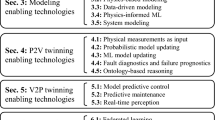Abstract
This paper presents an optimum design method to support the total micro-electromechanical systems (MEMS) product/device optimization, and its evaluation at the conceptual stage itself using the multiple attribute decision making method. In the traditional MEMS product development cycle, simulation and design using software tools are very important due to the knowledge limitation and complexity in design, fabrication, and packaging processes. The available tools are time consuming and relay on trial and error to achieve an optimum solution. The proposed method simplifies the relationship between parameters of design, fabrication, materials, packaging, and the performance of the MEMS product. The methodology is explained with the help of design flow diagram and time chart. A MEMS-based radio frequency (RF) power sensor is designed and the methodology is demonstrated. The proposed sensitivity analysis method is more effective and less time consuming than traditional techniques. Sensitivity analysis is carried out by varying the thickness of the signal conductor. The results of RF power sensor with insertion loss 0.428 dB, reflection loss 25.956 and voltage standing wave ratio of 1.106 at 1.5 GHz are reported.
Similar content being viewed by others
References
Lee S, Kim C, Jung S, Song I-S, Cho YC (2001) MEMS for IT applications. Proc Int Sym Micromech Human Sci. doi:10.1109/MHS.2001.965216
Mukherjee T (2003) MEMS design and verification. Proc Int Test Conf. doi:10.1109/TEST.2003.1270897
Fedder GK (1999) Structured design of integrated MEMS. Proceedings of the 12th IEEE International Conference on MEMS. doi:10.1109/MEMSYS.1999.746742
Saloman P (2000) Towards dedicated tools for microsystems. Int News Microsys MEMS 5:4–7
Estibals B, Fourniols J-Y, Noullet L, Martinez A (2001) MEMS design, realization and characterization in an educational context. Eng Sci Edu J. doi:10.1049/esej:20010508
Maseeh F, Harris RM, Senturia SD (1990) A CAD architecture for microelectromechanical systems. Proc IEEE Conf Micro Electro Mech Syst. doi:10.1109/MEMSYS.1990.110246
Da Silva MG, Giasolli R, Cunningham S, DeRoo D (2002) MEMS design for manufacturability (DFM). Sensors Expo & Conference. http://www.coventor.com/pdfs/sensorsexpo_2002.pdf. Accessed on 22 Oct 2011.
Mamiya H, Ishikawa K, Yu Q (2004) A new MEMS optimal design method using CASE. Inter Conf Thermal Thermomech Phen Elect Sys. doi:10.1109/ITHERM.2004.1318329
Senturia SD (1998) CAD challenges for microsensors, microactuators, and microsystems. Proc IEEE 86:1611–1626. doi:10.1109/5.704266
Fedder GK (2000) Top down design of MEMS. Technical Proceedings of the International Conference on Modeling and Simulation of Microsystems, http://www.nsti.org/procs/MSM2000/1/M1.02. Accessed on 22 Oct 2011.
Farnsworth M, Benkhelifa E, Tiwari A, Zhu M, Moniri M (2011) An efficient evolutionary multi-objective framework for MEMS design optimisation: validation, comparison and analysis. J Memetic Comput 3:175–197. doi:10.1007/s12293-011-0067-6
Ongkodjojo A, Tay FEH (2006) Techniques in global optimal design for MEMS & their applications. In Leondes CT (ed.) MEMS/NEMS handbook–techniques and applications. Springer. pp 151–172. doi:10.1007/0-387-25786-1_5
Brenner MP, Lang JH, Li J, Qiu J, Slocum A (2002) Optimum design of a MEMS relay switch. Nano Tech 1:214–217
Coultate JK, Fox CHJ, McWilliam S, Malvern AR (2008) Application of optimal and robust design methods to a MEMS accelerometer. Sensors Actuators A: Phys 142(1):88–96. doi:10.1016/j.sna.2007.04.033
Huang L, Wu GL, Zhu SZ, Huang Y, Pei M, Huang ZJ, Zhou N (2001) Exploring the optimal design of a new MEMS phase shifter using genetic algorithms. Gen Evol Comp Conf. doi:10.1.1.73.4798
Heo S, Kim YY (2007) Optimal design and fabrication of MEMS rotary thermal actuators. J Micromech Microeng 17:2241–2247. doi:10.1088/0960-1317/17/11/010
Prince AA, Agrawal VP (2009) Coding, evaluation, comparison, ranking, and optimum selection of microelectromechanical system (MEMS) products. Int J Mechatron Manufact Syst 2:97–119. doi:10.1504/IJMMS.2009.024350
Prince AA, Agrawal VP (2010) A group decision making aid for evaluation and optimum selection of microelectromechanical systems (MEMS) products. J Mechatron Intel Manufact 1(1/2):3–24
Mansour RR, Bakri-Kassem M, Daneshmand M, Messiha N (2003) RF MEMS devices. Proc Int Conf MEMS NANO Smart Sys. doi:10.1109/ICMENS.2003.1221974
Yan X (2010) Framework Model of MEMS design process management. Int J Int Manu Serv 2:340–353. doi:10.1504/IJIMS.2010.033942
Fernandez LJ, Visser E, Sese J, Wiegerink R, Jansen H, Flokstra J, Elwenspoek M (2004) Development of a capacitive MEMS RF power sensor without dissipative losses towards a new philosophy of RF power sensing. Proc Prec Electro Meas Digest. doi:10.1109/CPEM.2004.305488
Seppa H, Kyynarainen J, Oja A (2001) Microelectromechanical systems in electrical metrology. IEEE Trans Instrum Meas 50:440–444. doi:10.1109/19.918161
Fernandez LJ, Wiegerink RJ, Flokstra J, Sese J, Jansen HV, Elwenspoek M (2006) A capacitive RF power sensor based on MEMS technology. J Micromech Microeng 16:1099–1107. doi:10.1088/0960-1317/16/7/001
Crary SB (1995) Structured design methods for MEMS. Workshop Sponsored by National Science Foundation, http://design.caltech.edu/NSF_MEMS_Workshop/. Accessed on 22 Oct 2011.
Author information
Authors and Affiliations
Corresponding author
Rights and permissions
About this article
Cite this article
Prince, A.A., Jose, I. & Agrawal, V.P. A new optimal design and analysis method based on MADM for MEMS products development. Int J Adv Manuf Technol 63, 851–861 (2012). https://doi.org/10.1007/s00170-012-3969-7
Received:
Accepted:
Published:
Issue Date:
DOI: https://doi.org/10.1007/s00170-012-3969-7




